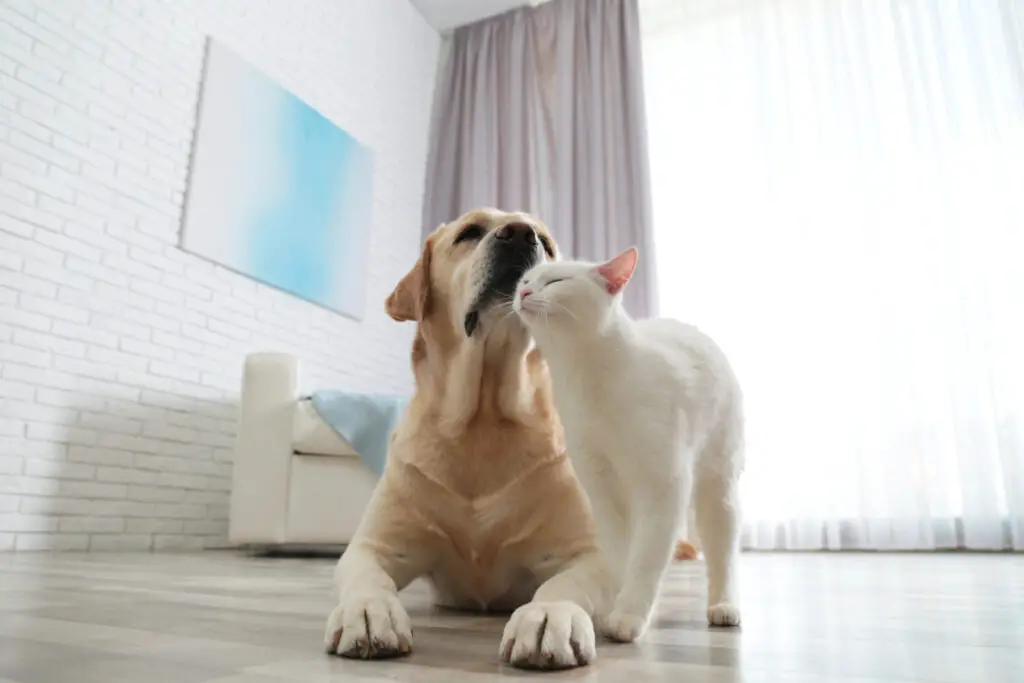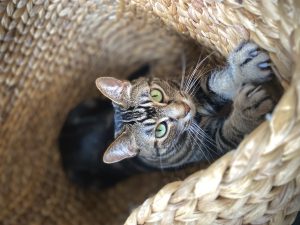What Your Cat’s Purr Means – Guide to the 5 Types of Purring
Think your cat only purrs when happy? Think again. While purring often signals contentment, cats also purr when hungry, stressed, in pain, or even close to death.

Key Takeaways:
- Cats purr for multiple reasons beyond happiness
- Context and body language provide clues
- Different types of purrs serve different purposes
- Changes in purring patterns can signal health issues
- Understanding purr meanings improves cat care
Key Terms:
- Solicitation Purr: Special purr used to request food or attention
- Social Purr: Purring used for bonding and communication
- Comfort Purr: Self-soothing purring during stress or pain
- Contentment Purr: Classic happy purring during relaxation
Recent research reveals that cats have evolved several distinct types of purrs, each serving different communication purposes.
They even purr as a way of playing us for food – just one of the five types of purring. Read on to learn about each one.
The 5 Types of Purrs
Just as humans have different tones of voice, cats have different types of purrs. Learning to distinguish between them helps you better understand and respond to your cat’s needs.
- The Contentment Purr
This is the one most people associate with cats – the classic happy purr. The “I love you” purr. This is your chance to have a slow-blink exchange with your cat.
- Maintains steady volume
- Occurs during relaxation
- Accompanies relaxed body language
- Starts and stops smoothly
- Often includes closed eyes or slow blinks
- The Solicitation Purr
I love this one. I usually don’t like to be manipulated, but it’s easy to make an exception with my cats. This is the “feed me” or “give me attention” purr. Manipulation drenched in cuteness!
- Contains a high-pitched element
- Sounds more urgent
- Often includes meowing
- Increases when you respond
- Commonly occurs at meal times
- The Greeting Purr
This is the social purr. It occurs when welcoming familiar people or cats, or even other animals, like the family dog.
- Starts as cat approaches
- Often combined with trilling
- Includes upright tail position
- Features happy body language
- May include rubbing or bunting behavior
- The Self-Soothing Purr
During stress or pain, cats may purr to comfort themselves. This purr is even thought to have healing effects.
- Quieter volume
- More internal vibration
- Tense body posture
- Withdrawn behavior
- Continuous duration
- The Social Bonding Purr
This one originates in the first days of life in exchanges between kitten and mama. It’s used to strengthen relationships through:
- Gentle, consistent rhythm
- Combined with physical contact
- Mutual purring between cats
- Relaxed body language
- Positive social context
Understanding these different purr types helps you better respond to your cat’s needs.
Context is Key
A purr alone doesn’t tell the whole story. To truly understand what your cat is communicating, you need to consider the complete picture – including body language, environment, and timing.
Body Language Clues
Watch for these physical signals:
- Ear position (forward, flat, or relaxed)
- Tail position and movement
- Muscle tension or relaxation
- Whisker position
- Eye expression and blinking
Environmental Context
Consider what’s happening around your cat:
- Time of day
- Location in the house
- Recent changes or events
- Presence of other animals
- Nearby activities
Combined Signals
Purring often occurs with other behaviors:
- Meowing or trilling
- Kneading with paws
- Head bunting
- Rolling or stretching
- Grooming behavior
Social Situation
Take note of who’s there:
- Familiar people vs strangers
- Other pets
- Recent visitors
- Group dynamics
- Social interactions
These contextual clues can help you decode your cat’s purring messages.
Common Purring Scenarios
Understanding typical situations where cats purr helps you interpret what they’re trying to communicate. Let’s explore the most common purring scenarios and what they usually mean.
As you’ll see, most contexts are positive as you’d expect. But there are exceptions that align with the self-soothing purr type…
During Petting/Grooming
When your cat purrs while being petted, they might be:
- Expressing contentment
- Strengthening social bonds
- Encouraging you to continue
- Showing trust
- Reciprocating affection
Mealtime Moments
Purring around food often means:
- Requesting to be fed
- Showing excitement for food
- Expressing gratitude while eating
- Seeking attention
- Trying to hurry you up
Resting and Sleeping
During relaxation, purring can indicate:
- Deep contentment
- Entering sleep state
- Natural healing mode
- Complete security
Social Situations
When interacting with others, purring might signal:
- Friendly greetings
- Desire for attention
- Social bonding
- Non-aggressive intentions
- Positive recognition
Stressful Times
During challenging situations, purring could mean:
- Self-soothing
- Pain management
- Anxiety relief
- Seeking comfort
- Expressing discomfort
When Purring Changes
When should you be concerned? Changes in your cat’s purring patterns can provide important clues about their health and well-being.
Being alert to these changes helps you spot potential problems early.
Age-Related Changes
As cats age, their purring might show:
- Different frequencies
- Changed duration
- Varied intensity
- New patterns
- Altered contexts
Health-Related Changes
Watch for purring changes that might indicate illness:
- Unusual timing
- Unexpected situations
- Different sound quality
- Changed intensity
- New patterns
Stress-Induced Changes
During stressful periods, purring may:
- Become more frequent
- Sound different
- Occur at odd times
- Accompany hiding
- Include other vocalizations
Environmental Impacts
Changes in surroundings can affect purring:
- New living spaces
- Different routines
- New family members
- Other pets
- Seasonal changes
Understanding these variations may actually help you monitor your cat’s well-being.
Warning Signs
While purring is usually positive, certain purring patterns might signal problems requiring veterinary attention. Knowing these warning signs might help you act quickly if needed.
Concerning Purring Patterns
Watch for:
- Excessive purring without clear cause
- Purring while avoiding interaction
- Unusual changes in purr volume
- Purring with signs of distress
- Sudden changes in purring habits
Red Flag Combinations
Of course, any of these behaviors could be reason to consult with your vet even when not combined with stress-purring, especially when lasting more than a day or two. But be alert when purring occurs with:
- Lethargy or weakness
- Loss of appetite
- Unusual aggression
- Behavior changes
- Physical symptoms
Location-Specific Purring
Pay attention if your cat:
- Purrs while avoiding certain movements
- Shows sensitivity to touch while purring
- Purrs excessively in unusual places
- Frequently purrs in hiding spots
- Purrs while limping or favoring areas
When in doubt, give your vet a call for a quick consultation if you see concerning behaviors or symptoms. They will let you know if it’s something your cat should be seen for.
Last Meows
Now you know your cat’s purring isn’t always an expression of their undying love for you.
Although that’s probably what it is most of the time, it can also be in response to stress or pain, or straight up manipulation for food.
